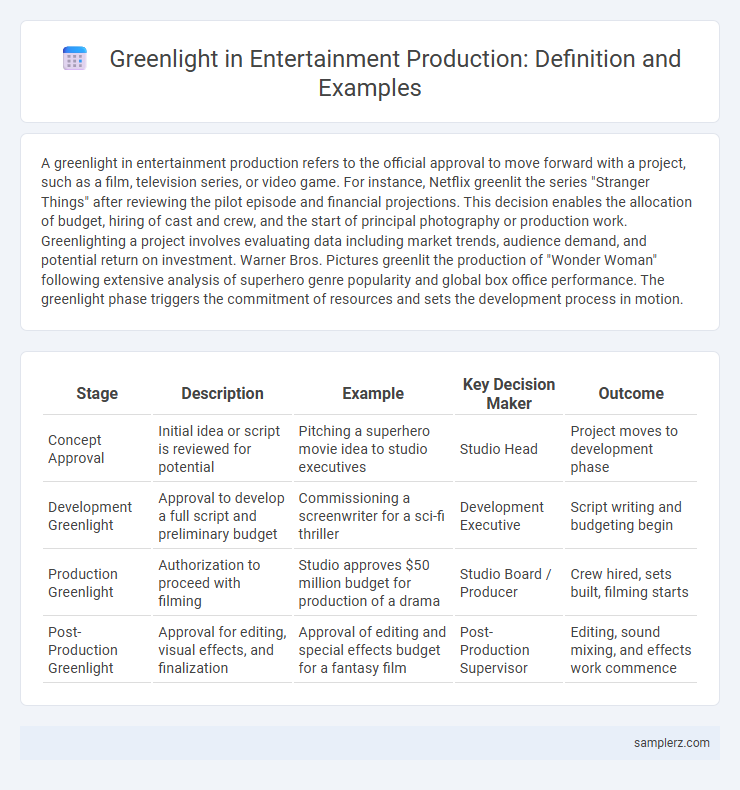A greenlight in entertainment production refers to the official approval to move forward with a project, such as a film, television series, or video game. For instance, Netflix greenlit the series "Stranger Things" after reviewing the pilot episode and financial projections. This decision enables the allocation of budget, hiring of cast and crew, and the start of principal photography or production work. Greenlighting a project involves evaluating data including market trends, audience demand, and potential return on investment. Warner Bros. Pictures greenlit the production of "Wonder Woman" following extensive analysis of superhero genre popularity and global box office performance. The greenlight phase triggers the commitment of resources and sets the development process in motion.
Table of Comparison
| Stage | Description | Example | Key Decision Maker | Outcome |
|---|---|---|---|---|
| Concept Approval | Initial idea or script is reviewed for potential | Pitching a superhero movie idea to studio executives | Studio Head | Project moves to development phase |
| Development Greenlight | Approval to develop a full script and preliminary budget | Commissioning a screenwriter for a sci-fi thriller | Development Executive | Script writing and budgeting begin |
| Production Greenlight | Authorization to proceed with filming | Studio approves $50 million budget for production of a drama | Studio Board / Producer | Crew hired, sets built, filming starts |
| Post-Production Greenlight | Approval for editing, visual effects, and finalization | Approval of editing and special effects budget for a fantasy film | Post-Production Supervisor | Editing, sound mixing, and effects work commence |
Understanding Greenlight in Entertainment Production
Greenlight in entertainment production refers to the official approval granting a project the go-ahead to proceed with funding and development, often following script review and budgeting assessments. This stage signals that studios or investors have evaluated potential profitability and market appeal, enabling the allocation of resources toward pre-production and filming. Understanding greenlight processes helps clarify decision-making criteria and risk management in producing movies, TV shows, or digital content.
Key Examples of Successful Greenlight Decisions
The greenlight decision for the Marvel Cinematic Universe, starting with "Iron Man" in 2008, exemplifies a successful production investment that yielded massive global box office revenue exceeding $22 billion. Warner Bros.' approval of "The Matrix" (1999) showcased innovative storytelling and groundbreaking visual effects, leading to critical acclaim and establishing a lucrative franchise. Pixar's greenlight of "Toy Story" revolutionized animated films, achieving commercial success and spawning multiple sequels that continue to dominate the market.
Iconic Films That Were Greenlit Against the Odds
The production of *Jaws* faced significant skepticism due to its high budget and ambitious underwater scenes but received a greenlight that ultimately revolutionized the blockbuster era. Similarly, *Star Wars* was greenlit despite concerns over its unconventional space opera narrative and unproven director George Lucas, which later became a cultural phenomenon. *The Blair Witch Project* secured funding with a minimal budget and an uncharted found-footage style, defying expectations to become a massive commercial success.
TV Shows That Received the Greenlight After Rejection
TV shows like "Breaking Bad" and "Parks and Recreation" were initially rejected before receiving the greenlight from major networks, demonstrating that perseverance can lead to successful production deals. These examples highlight how showrunners can refine pilots and pitches to meet network standards and audience expectations. Greenlighting after rejection often results from strategic revisions, market demand, and evolving network priorities in the entertainment industry.
The Role of Studio Executives in Greenlighting Projects
Studio executives play a crucial role in greenlighting projects by evaluating scripts, budgets, and market potential to approve film and television productions. Their decisions impact the allocation of millions in production costs and influence the creative direction, often determining whether a project moves from development to production. Key factors include analysis of audience demographics, forecasted revenue, and alignment with the studio's strategic goals.
Surprising Greenlight Stories in Streaming Platforms
Netflix's surprise greenlight for "Stranger Things" season 4 came after observing strong fan engagement with early teasers, bypassing traditional pilot episodes. Amazon Prime Video approved "The Marvelous Mrs. Maisel" for multiple seasons based on a single episode screening at industry events, defying standard pilot testing. Hulu swiftly greenlit "The Handmaid's Tale" after securing high-profile talent, capitalizing on timely social themes to accelerate production timelines.
Indie Productions That Got the Greenlight
Indie productions like "Moonlight," which received a greenlight from A24, showcase the potential for low-budget, artist-driven films to secure funding and critical acclaim. Films such as "Get Out" also demonstrate how independent projects can attract major studio backing after initial greenlighting based on unique storytelling and cultural relevance. These successes highlight the increasing willingness of studios to invest in diverse, original indie content during the greenlight phase.
Factors Influencing the Greenlight Process
Studios base the greenlight decision on factors such as market trends, budget feasibility, and potential return on investment. Audience demand and franchise viability play crucial roles in mitigating financial risks. Securing talent attachment and aligning with distribution strategies further influence project approval in the production phase.
High-Risk Projects That Became Greenlight Successes
High-risk entertainment projects such as James Cameron's *Avatar* and Christopher Nolan's *Inception* became greenlight successes despite initial budget and conceptual challenges. Studios approved these projects based on innovative storytelling potential and anticipated strong box office returns, leading to record-breaking revenue and critical acclaim. This demonstrates how strategic greenlighting of high-risk productions can yield significant financial and cultural payoff.
Lessons Learned from Notable Greenlight Examples
The greenlight of the Marvel Cinematic Universe's Iron Man in 2006 demonstrated the importance of strong intellectual property coupled with a clear creative vision and strategic budgeting. DreamWorks' initial hesitation to greenlight Shrek was overcome by recognizing the growing demand for family-friendly animation with innovative storytelling, emphasizing market trends as a critical factor. These examples teach that successful greenlights rely on aligning creative risk with audience insights and financial feasibility to maximize production potential.

example of greenlight in production Infographic
 samplerz.com
samplerz.com